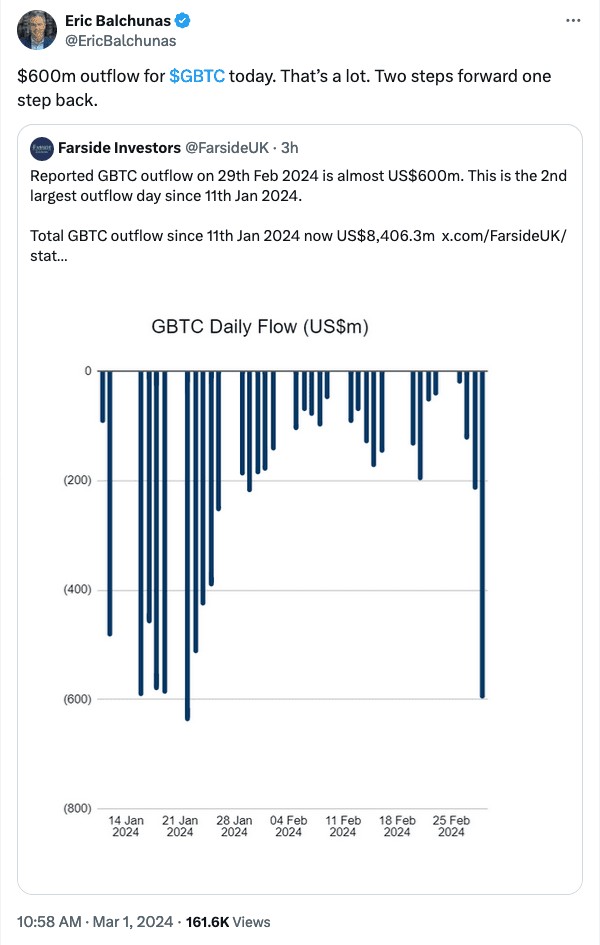[Massive outflow of GBTC funds] Bitcoin’s plunge caused panic, and analysts predict that the price may drop another 20%!Bitcoin suffers 3% correction as GBTC investors sell off nearly $6 billionBitcoin has fallen more than 3% from its 24-hour high as investors in Grayscale’s spot Bitcoin exchange-traded fund (ETF) dumped $5.989 billion from the fund on February 29. It was the second largest net outflow on record.Bitcoin hit a 24-hour high of $63,585 early on February 29, before falling about 3.3% to under $61,500, according to data from Cointelegraph Markets Pro.The near-record outflow comes as the Grayscale Bitcoin Trust (GBTC) — the asset manager’s recent switch to an ETF — saw daily net outflows reach $6 billion on February 29, according to preliminary Farside Investor data.This is the ETF’s second-highest net outflow day since January 22, when it recorded a record net outflow of $6.405 billion.Bloomberg senior ETF analyst Eric Balciunas commented on the day’s outflows in a Feb. 29 X post, writing: “It’s really a lot.”Just a few days ago, GBTC recorded its lowest ever daily net outflow of just $22.4 million on February 26."Two steps forward, one step back," Balciunas added.On Wednesday, February 28, ten U.S. spot Bitcoin ETFs saw record combined net inflows of $673.4 million, as Bitcoin hit a more than two-year high of $64,000.The latest GBTC outflow may impact the day’s inflows. While full inflow data for the other nine ETFs is not yet available, Farside’s data for February 29 has shown that the Fidelity Bitcoin ETF, one of the top three funds by assets, saw net inflows of just $44.8 million. , its fourth-lowest inflow day.Meanwhile, in a recent memo to investors, analysts at JPMorgan warned that the price of Bitcoin could fall after the “halving mania” subsides.It is widely believed that April’s Bitcoin halving event could push the price of Bitcoin higher, but it may have the opposite effect, driving its price down to $42,000, according to a memo seen by Bloomberg on February 29.The Bitcoin halving event, which reduces the Bitcoin block reward from 6.25 BTC to 3.125 BTC, is a historic catalyst for Bitcoin price increases because miners' production costs usually rise afterwards.Analysts say the production cost - the cost of mining one Bitcoin - is considered a theoretical minimum for Bitcoin's price and should "mechanically double" to $53,000 after the halving.However, mining difficulty may be 20% lower than originally estimated, lowering production costs and Bitcoin prices, meaning the cryptocurrency could fall to $42,000 after April’s halving.Analysts calculated the additional 20% mining difficulty drop by assuming that some miners with inefficient mining machines who do not have enough funds to upgrade their mining machines will shut down their equipment.This would reduce Bitcoin’s hashrate — and its mining difficulty — by an estimated 20%, in line with estimates from Galaxy Digital last month.Analysts admit that a decrease in mining difficulty may not happen because inefficient mining equipment may still be profitable while the price of Bitcoin remains elevated, especially due to demand for Bitcoin ETFs.


